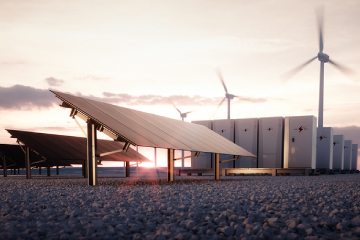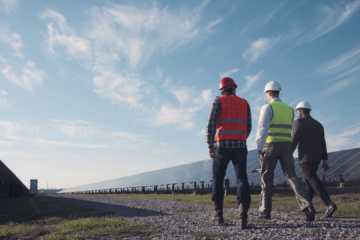- About UsAbout UsWe’re committed to providing future generations with the means to power their lives in the most economic, environmental and socially responsible ways possible.
- What We DoWhat We DoWe are a market-leading, independent power producer and service provider, delivering: wind (onshore and offshore), solar photovoltaic, storage, and electrical vehicle charging.
- Landowners
- Suppliers
- Projects
- Careers
- News
- Contact
G&T Cooperatives and Distributed Solar: A Perfect Pairing

By Sterling Root, Associate Director, Business Development
While many city dwellers may not realize it, electric cooperatives provide critical infrastructure for much of rural America. According to the National Rural Electric Cooperative Association (NRECA), America’s 831 distribution cooperatives serve 42 million people, powering “over 21 million businesses, homes, schools and farms in 48 states.” Many of the nation’s distribution cooperatives are served by generation and transmission (G&T) cooperatives, which “provide wholesale power…through their own electric generation facilities or by purchasing power on behalf of the distribution members.”[1]
Over the past decade, distribution cooperatives as well as G&Ts have embraced renewable energy sources like wind and solar, recognizing that they provide a planet-friendly way to provide clean, reliable power to their members while also delivering significant cost savings. This has helped cooperatives significantly increase their renewable capacity from 3.9 gigawatts to more than 13 gigawatts, according to NRECA.
As many distribution and G&T cooperatives have discovered, distributed solar offers tremendous flexibility in siting, which makes it an ideal solution to their needs for several reasons.
First, it offers a cost-effective solution to meeting local demand. Cooperatives, and particularly G&T cooperatives, often have vast, sparsely populated service territories. While investor-owned utilities (IOU) typically have 34 customers per mile of line, cooperatives average just 7.4! This means cooperatives incur much higher transmission and distribution costs relative to their IOU counterparts and thus benefit greatly from the ability to place generation closer to load.
A related but equally important economic benefit is that distributed solar projects are often able to avoid the need to participate in Independent System Operators (ISO) queue processes, greatly reducing the timeline and cost of project delivery.
Second, distributed solar enables G&Ts to be responsive to the members they serve by placing individual projects in each member cooperative’s service territory. Rural distribution cooperatives often have access to inexpensive land, and solar projects can be a smart way to leverage marginal land that is unsuitable for other purposes.
A third benefit is that locally sited projects offer the opportunity for each distribution member to enhance its visibility in the community. Features like educational kiosks and displays showing clean energy production in real time are a great way to illustrate how the project is contributing to the sustainability of the local grid and the community.
Finally, given the recently passed Inflation Reduction Act, cooperatives will now be able to take advantage of direct payment provisions to draw down the cost of their projects should they take ownership stakes.
Depending on the size of a G&T’s service territory, delivering a portfolio of projects can take less than 24 months. The process starts with a collaborative assessment of the G&T’s existing portfolio, opportunities and needs, followed by preliminary site selection and project design, including interconnection and system integration considerations.
Once the full project’s scope and design are finalized, work on individual projects can begin. As one of the nation’s leaders in the development and construction of renewable energy projects, EDF Renewables offers a one-stop-shop that can perform full project development, engineering, procurement, and construction (EPC) services, as well as operations and maintenance (O&M) on completed projects if desired. Construction of a distributed solar project typically takes 8-10 months and benefits the local economy through job creation as well as increased demand for goods and services.
Clients benefit from EDF Renewables more than 35 years’ of experience developing, siting and permitting renewable energy projects, which is leveraged to avoid surprises and minimize delivery time. In addition, a portfolio approach creates value through economies of scale and system-wide project optimization to ensure the maximum production of clean power.
EDF Renewables strongly support our nation’s electric cooperatives and believe that distributed solar is an ideal choice for G&Ts seeking to add clean, affordable, stably priced electricity to their portfolios. With decades of experience developing wind, solar and energy storage projects across North America, we are ideally positioned to help organizations of any size meet customer demand for renewable energy.
EDF Renewables has developed several projects for distribution cooperatives, including several projects for Old Dominion Electric Cooperative, 13 MW of distributed solar projects for Connexus Energy in Minnesota, and the 3.4 MW Flambeau Solar project for Dairyland Power Cooperative in Wisconsin.
[1] https://www.electric.coop/electric-cooperative-fact-sheet
Post a Comment Cancel reply
- © 2025 EDF Renewables North America
- Privacy Policy
- AB 1305 Disclosure
- TCFD Report



Comments (2)
Excellent. As former NRECA Senior Corporate Counsel and a leader in Texas renewable energy and Texas high-voltage transmission policy, I am of course excited to hear about intensive future linkages between G&T Cooperatives and renewable energy.
Thanks for the support Greg!